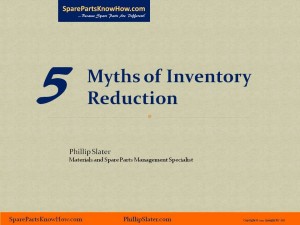 This myth probably adds more to the investment in inventory than any other. The opportunities for consignment stock are many and are largely ignored because of the belief that it costs more.
This myth probably adds more to the investment in inventory than any other. The opportunities for consignment stock are many and are largely ignored because of the belief that it costs more.
Firstly, arranging to pay for items only at the time they are used, issued or sold is referred to as consignment stocking. In this case the supplier still owns the item until you need it.
As the supplier must now finance the stock and accept the inventory risk it is often believed that additional costs will be passed on to the purchaser. This is not, however, always the case.
Gaining control of stocking gives the supplier many more options to be proactive in the management of the supply chain.
For example, they can schedule manufacturing and deliveries to suit their timetable rather than be reactive to your purchase orders; they can draw on a wider network to manage safety stocks and they can even draw against your holding to supply other customers.
This flexibility can provide the supplier with the opportunity to reduce costs through improved manufacturing and supply chain efficiencies.
Some suppliers will still try to charge more for consignment stock, citing the investment cost and risk as the key reason. However, a sensible approach to consignment stock that identifies the supply chain opportunities can result in the double benefit of reduced inventory and reduced cost!
Case Study
In this case study the user company held a large supply of hydraulic hoses. They had tried using a call-out service to provide a hose when needed. However, they found this arrangement unsatisfactory because they sometimes had to wait too long for the service van to arrive. Hence they held a supply of hoses and fittings on site.
In negotiating a consignment deal, the supplier agreed to consignment stocking of this inventory on the basis that:
- The company would monitor holdings (and would be responsible for shortages).
- The supplier could restock at their convenience (hence, it became fill-in work).
- The supplier could draw on the stock for other local emergencies if required.
Under these arrangements the supplier was able to gain several efficiencies in working with the company. As a result, it was not under pressure to increase its prices.
In this win-win situation, the user company gained a $100,000 inventory reduction with no increase in their risk.
For information on our Pro Level membership please visit our Pro Level page.
Posted by: Phillip Slater